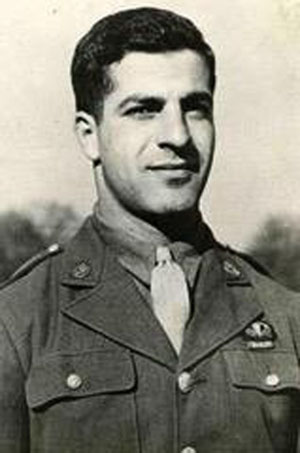
Courtesy Martin/Portaro family

Remember...
Nicolangelo (Nick A.) Cavallaro
1920-1945
"A hero is someone who has given his or her life to something bigger than oneself."
Joseph Campbell
 Courtesy Martin/Portaro family |
Remember...Nicolangelo (Nick A.) Cavallaro
|
Nicolangelo Cavallaro ("Nick") was born in Pezzolo, Reggio Calabria, Italy, on October 28, 1920, to Maria Rosa Strangio Cavallaro and Vincenzo Cavallaro. In August of 1922 Nick arrived in the United States with his mother and brother Celestino ("Charles") and went through immigration in Ellis Island, New York. The three met Vincenzo, who had come to the U.S. beforehand to obtain living arrangements for the family, and settled down in the city of Grasselli (now Anmoore) in north central West Virginia. Grasselli was a small town with the citizens' main employers being the Grasselli Chemical Company and a number of merchants and grocers. The area's population was comprised of many immigrant families like Nick's, mainly of Spanish and Italian background. (Source: Bob Stealey, "Before It Was Anmoore, It Was Steelton, Then It Was Grasselli," Clarksburg Exponent Telegram, 22 March 2000, accessed 24 May 2016, http://www.wvgenweb.org/harrison/clarkstel3.html.) Nick had six siblings: Ernie, Charlie, Angelina, Raymond, Violet, and Louise. Nick learned many skills from his father, such as farming, gardening, and the butchering of pigs and cattle. The town was a peaceful and happy place for this large family to reside in.
After finishing public schooling, Nick became employed at the Pittsburgh Plate Glass Company, located in Stonewood, West Virginia, which was about four miles away from Grasselli. Vincenzo was an employee there as well, and the two would go to work together every day via walking or by taking the community bus. The glass company was a main employer of the area, and Nick enjoyed his time there. Nick was generally a joyous and cheerful person and extremely well liked throughout the entire community.
When the Japanese attacked Pearl Harbor on December 7, 1941, it was not long before Nick enlisted in the army to fight for his country. He was assigned to the freshly formed 82nd Airborne Division, 505th Parachute Infantry Division. After this Nick was sent to Tunisia for his first experience with armed combat. The 82nd participated in seven major military campaigns throughout World War II. The invasion of Sicily was their first combat, and their second combat was a jump into Salerno, Italy, on September 14, 1943, in which they entered Naples before any other group. During this battle, Nick served as a valuable asset by translating Italian for his command.
On June 6, 1944, during the invasion of Europe at Normandy, France (more commonly known as D-Day), the 82nd and the 101st Airborne paratroopers jumped behind German lines at 3:00 a.m. and aided in securing a strong foothold which ultimately led to success in the invasion. The 82nd descended into Groesbeck, Holland, on September 17, 1944, and defeated the Germans in an intense fight. Nick was scheduled to come home on furlough during this time, but Germany made a big invasion into Belgium, causing all furloughs to be cancelled. Nick's division was then sent to Belgium for the Battle of the Bulge, which was a huge German offensive campaign launched through the Ardennes region. The Allied forces were caught completely off guard by this attack, and the U.S. Army pushed through the battle with the highest number of casualties for any operation during World War II. The German army also suffered many casualties on the Western front and was unable to replace them, setting them back in the war entirely. It was during the Battle of the Bulge at Fosse, Belgium, that Nick Cavallaro was killed by German machine-gun fire on January 3, 1945. (A detailed account of this military campaign is Hugh M. Cole's online book The Ardennes: Battle of the Bulge, Office of the Chief of Military History, Department of the Army, Washington, DC, 1965, accessed 24 May 2016, http://www.history.army.mil/books/wwii/7-8/7-8_cont.htm.)
William H. Tucker, a comrade of Nick Cavallaro in Company I, 3rd Battalion, 505th PIR, wrote two books that relate the experiences of I Company in World War II: Rendezvous at Rochelinval: Battle of the Bulge and Parachute Soldier: From the Diary of William H. Tucker 1942-1945. Specific mention is made of Nick Cavallaro and the fateful events of 3 January 1945, where he died in indisputably heroic circumstances.
In an email to West Virginia Archives and History (26 July 2019), Kevin Mulvaney writes:
I have extensive knowledge of the history of the company. I knew William Tucker personally. He was a good man, faithful to the memory of his comrades. I befriended him when my father passed away in 2003. My father, Pfc. James Paul Mulvaney, was also a member of I Company with three combat jumps. He was a close friend of Nick Cavallaro. My father told me he shared an interest in poetry and literature with one of his comrades and they helped some of the other guys write letters to their sweethearts back home. I am 95% sure this person was Nick Cavallaro. He was very attached to Nick, and his name would regularly come up in conversations about the war.Nick Cavallaro was a member of the unit that liberated the first town in France (Sainte-Mere-Eglise). Indeed, 3rd Battalion, 505th PIR accomplished its designated mission that night by securing the town around 5 a.m.-shortly before dawn-and repelling numerous counterattacks, thereby denying the German army access to the Utah Beach landing area.
Family information and Nick's military history provided by Louise and Thomas Martin (sister of Nick and her husband), Benjamin Portaro (first cousin of Nick), and his son Jim Portaro
Prepared by Iraj Hasan, Jordyn Johnson, and Nick Penix, George Washington High School, Advanced Placement U.S. History
May 2016; updated July 2019

West Virginia Archives and History welcomes any additional information that can be provided about these veterans, including photographs, family names, letters and other relevant personal history.